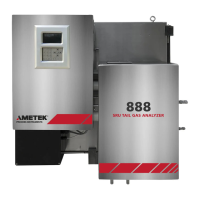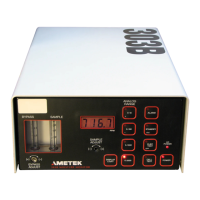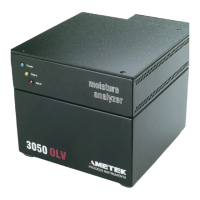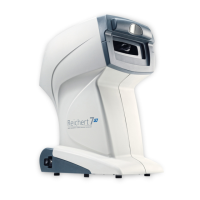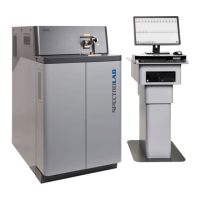Maintenance and Troubleshooting | 6-27
2. If the analyzer uses Measured Pressure Compensation (optional),
change it to Fixed mode so that a “f: Sample gas pressure too low”
alarm does not occur. To do this, view the Cell/Misc Parameters dialog
box and enter a value in the Default Cell Pres (pressure compensa-
tion) field that is the same as, or approximately, the Measuring Cell
pressure. Refer to “Cell/Miscellaneous (Compensation) Parameters” in
Chapter 4.
Close the sample inlet valve. Backpurge the analyzer sample system
with Zero gas for 2–3 minutes.
3. Change the Flow Control to ‘4’ (shut-in/shut-off). Click Apply (next to
Flow Control) and then click OK.
Bleed down the sample system to atmospheric pressure (check gauge).
Close the valve on the Vent Line (or cap the Vent outlet).
To avoid tearing the Membrane Filters in the Filterblock, always bleed
down the sample system pressure on the downstream (outlet) side of
the Filterblock. Pressure differentials of more than 210 KPA (30 PSI)
from the inlet side to the outlet side can tear the Filters and they will
have to be replaced.
4. Disconnect AC power to the analyzer and power down the computer
before performing maintenance on the analyzer.
5. Remove the existing lamps:
a. Remove the (24) M10 screws from the Upper Enclosure door and
open it.
b. Loosen – but do not remove – the (2) M3 x 8 screws on the Optical
Bench Microcontroller mounting bracket.
Swing the Microcontroller/Micro-Interface board assembly out-
ward.
c. Loosen the Lamp Retaining Screw on the bottom of the Lamp
Sockets and rotate the Lamp Retaining Bracket 90 degrees. Re-
move the Lamp Socket.
d. Remove each lamp by rotating and sliding it downward. If neces-
sary, loosen the Lamp Clamping Screw on the Lamp Compression
Bar.
Do not rotate or pull on the base of the source lamp because this may
cause it to separate from the glass envelope. Grasp the glass envelope
when rotating or pulling the source lamp.
!
CAUTION
!
CAUTION
Setup (tab)Cell/Misc

